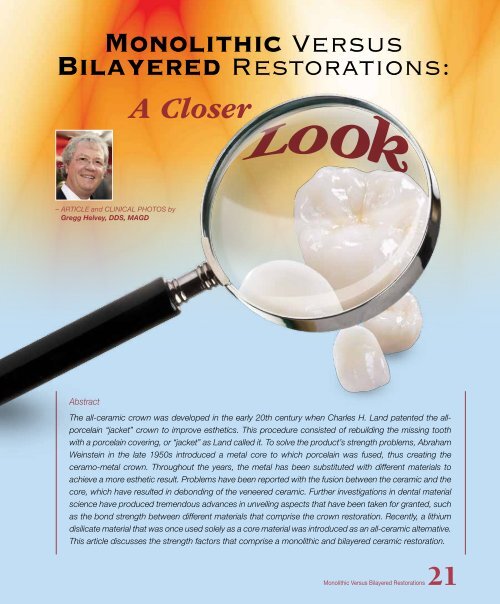Dr. Gordon Christensen The Dangers of - Glidewell Dental Labs
Dr. Gordon Christensen The Dangers of - Glidewell Dental Labs
Dr. Gordon Christensen The Dangers of - Glidewell Dental Labs
You also want an ePaper? Increase the reach of your titles
YUMPU automatically turns print PDFs into web optimized ePapers that Google loves.
Monolithic Versus<br />
Bilayered Restorations:<br />
A Closer<br />
– ARTICLE and CLINICAL PHOTOS by<br />
Gregg Helvey, DDS, MAGD<br />
Abstract<br />
<strong>The</strong> all-ceramic crown was developed in the early 20th century when Charles H. Land patented the allporcelain<br />
“jacket” crown to improve esthetics. This procedure consisted <strong>of</strong> rebuilding the missing tooth<br />
with a porcelain covering, or “jacket” as Land called it. To solve the product’s strength problems, Abraham<br />
Weinstein in the late 1950s introduced a metal core to which porcelain was fused, thus creating the<br />
ceramo-metal crown. Throughout the years, the metal has been substituted with different materials to<br />
achieve a more esthetic result. Problems have been reported with the fusion between the ceramic and the<br />
core, which have resulted in debonding <strong>of</strong> the veneered ceramic. Further investigations in dental material<br />
science have produced tremendous advances in unveiling aspects that have been taken for granted, such<br />
as the bond strength between different materials that comprise the crown restoration. Recently, a lithium<br />
disilicate material that was once used solely as a core material was introduced as an all-ceramic alternative.<br />
This article discusses the strength factors that comprise a monolithic and bilayered ceramic restoration.<br />
Monolithic Versus Bilayered Restorations21
















